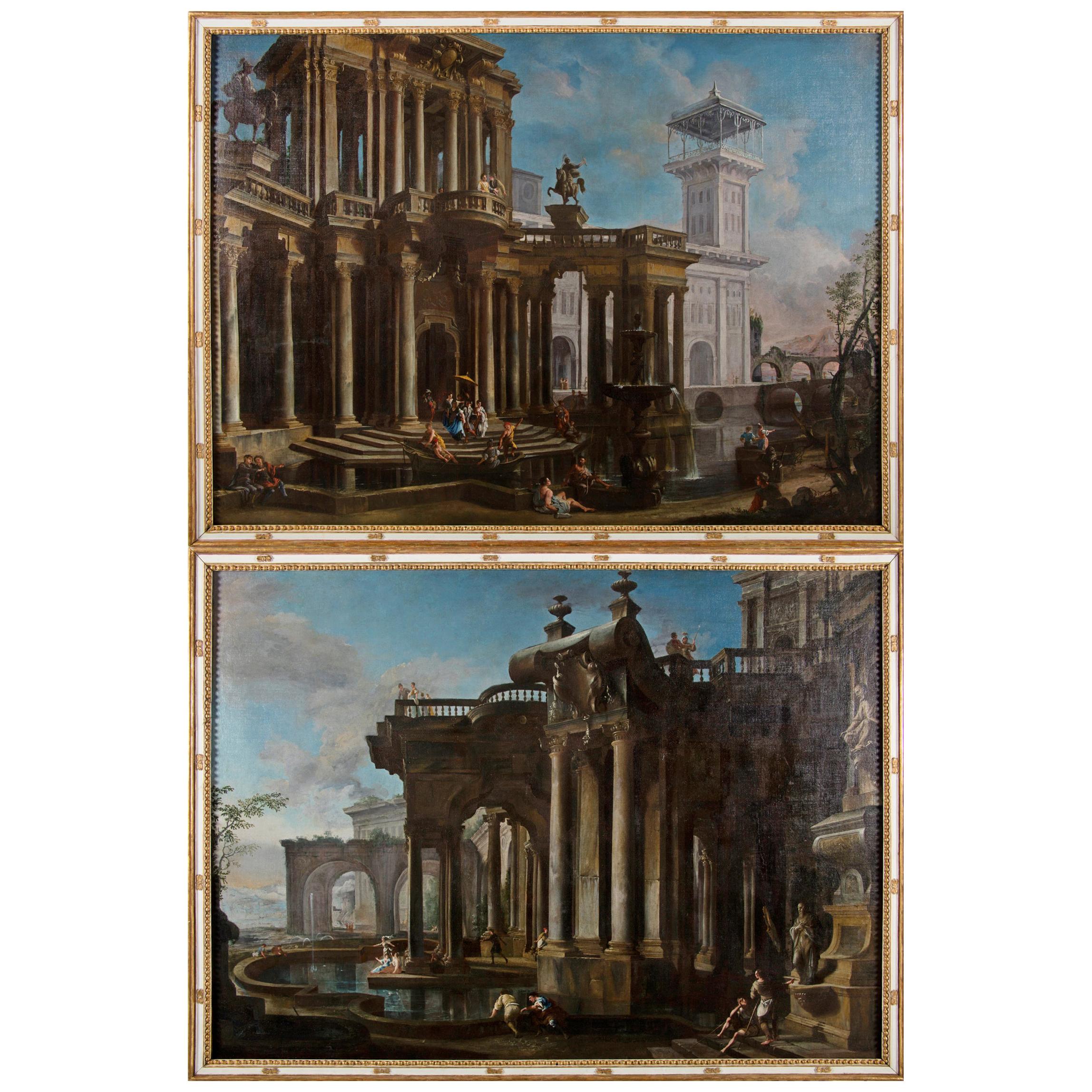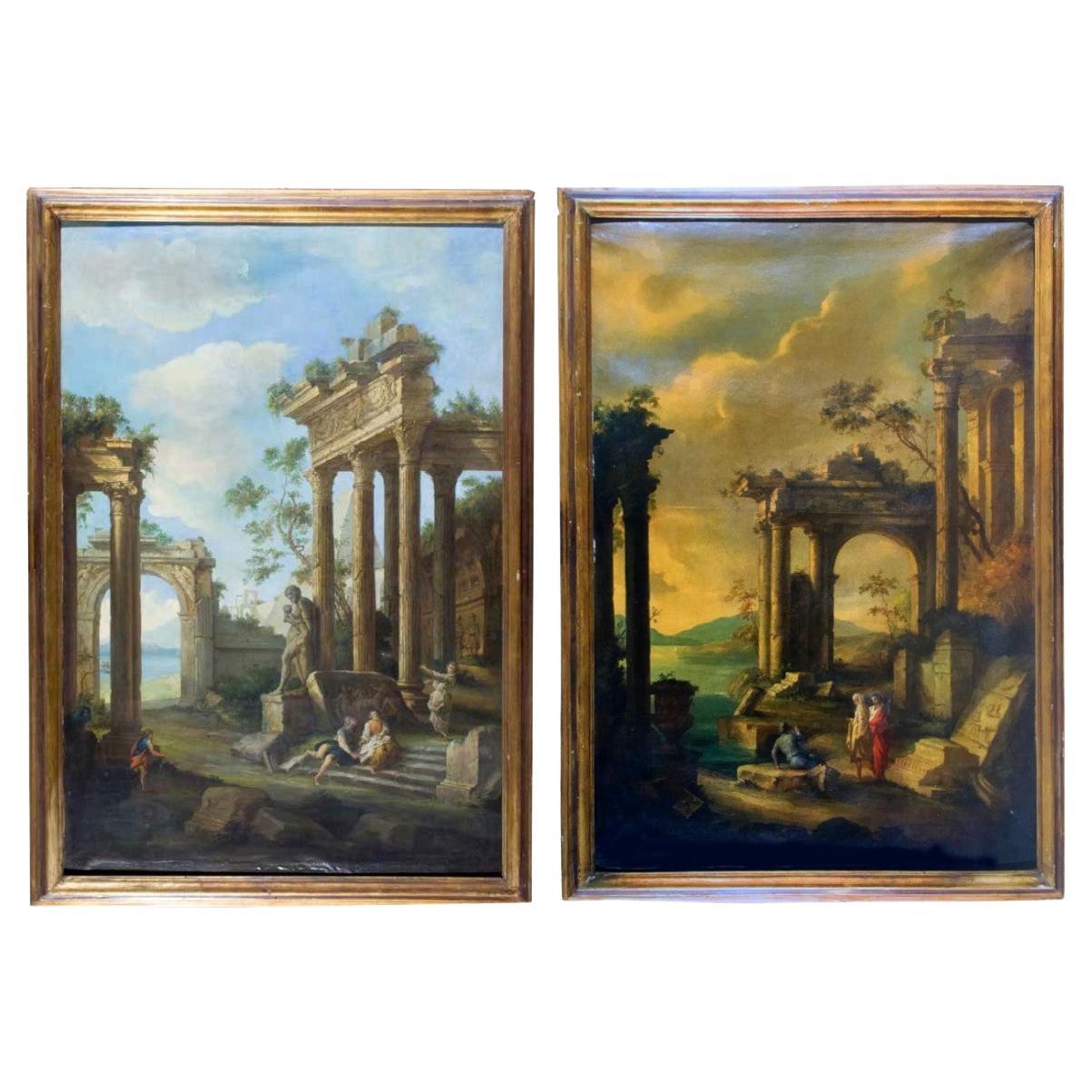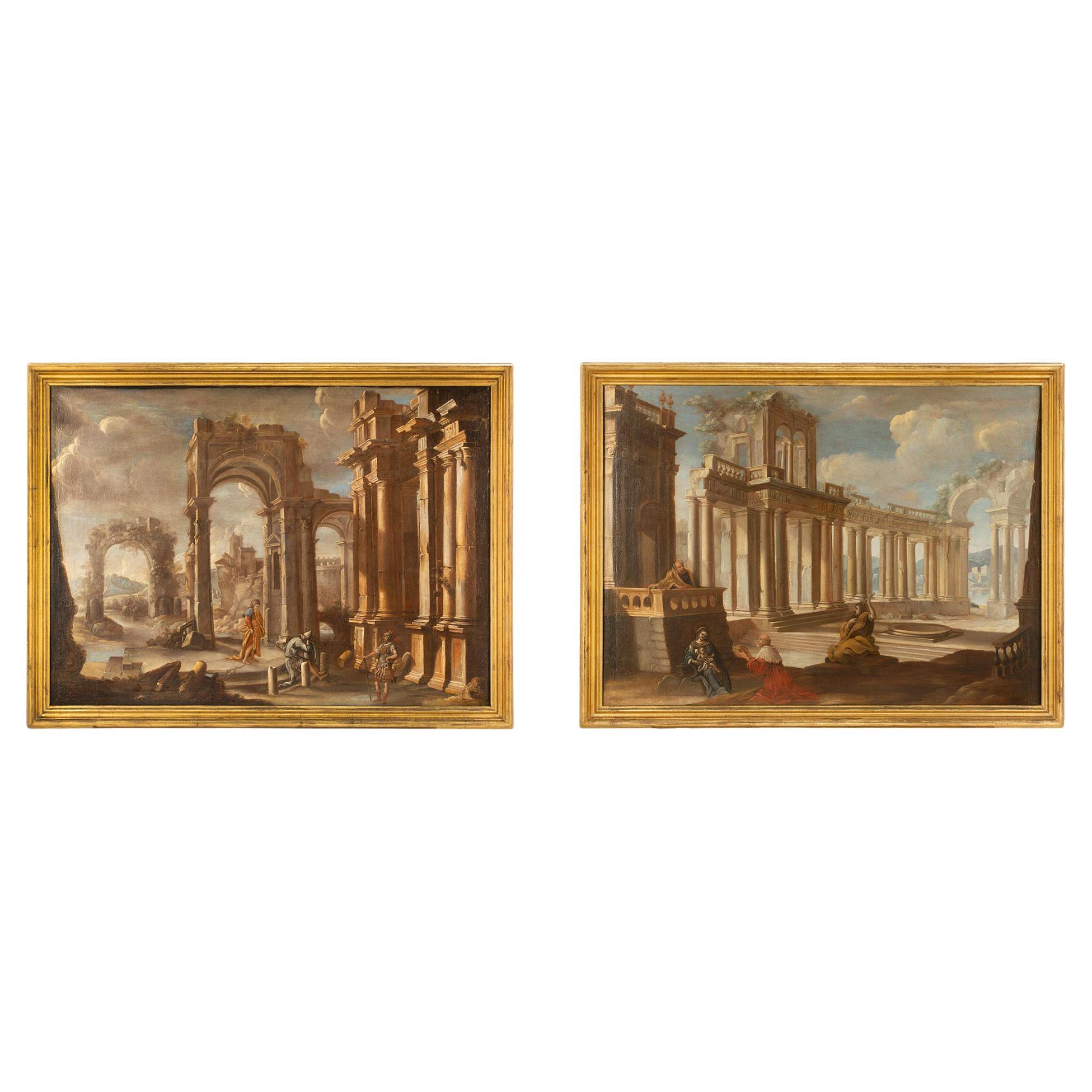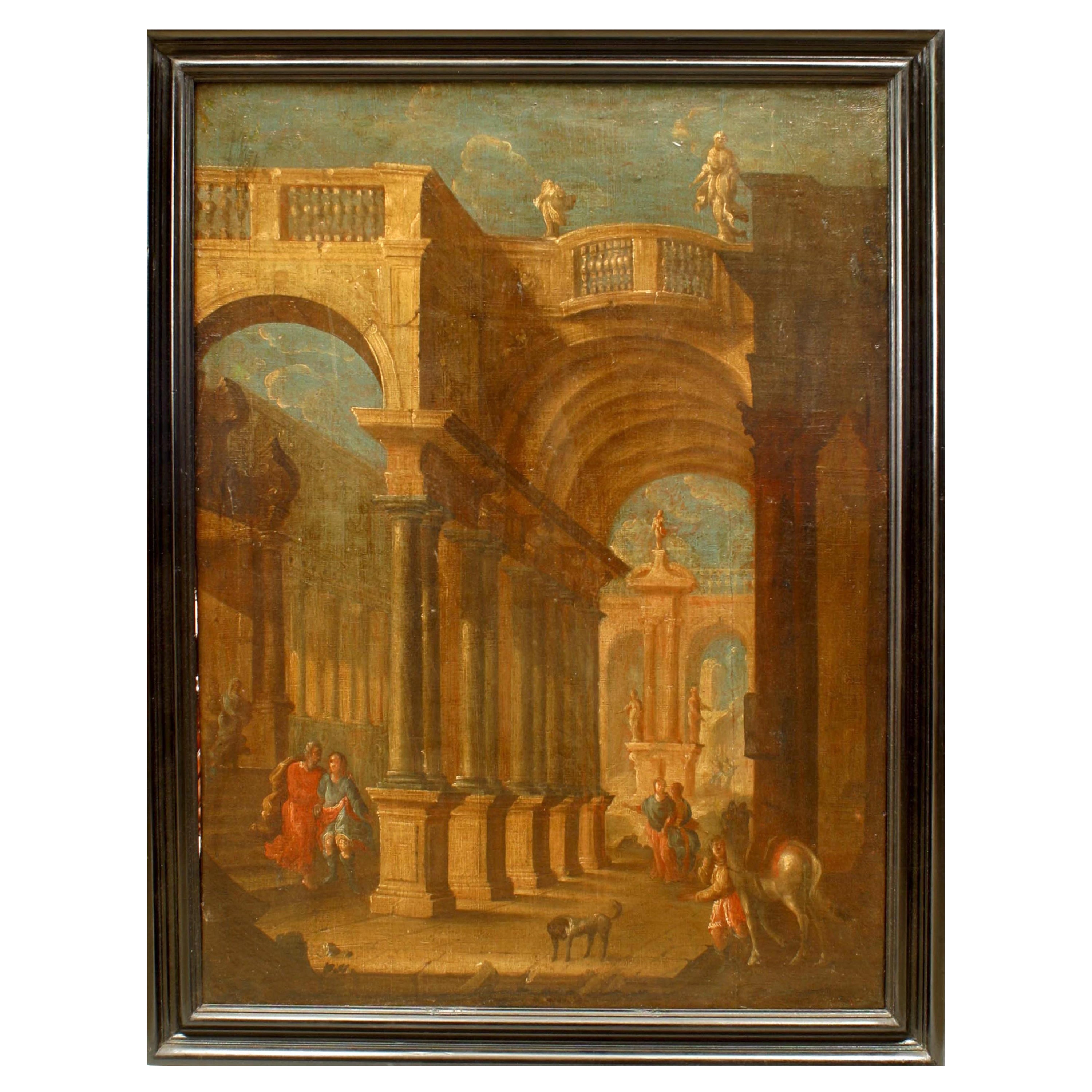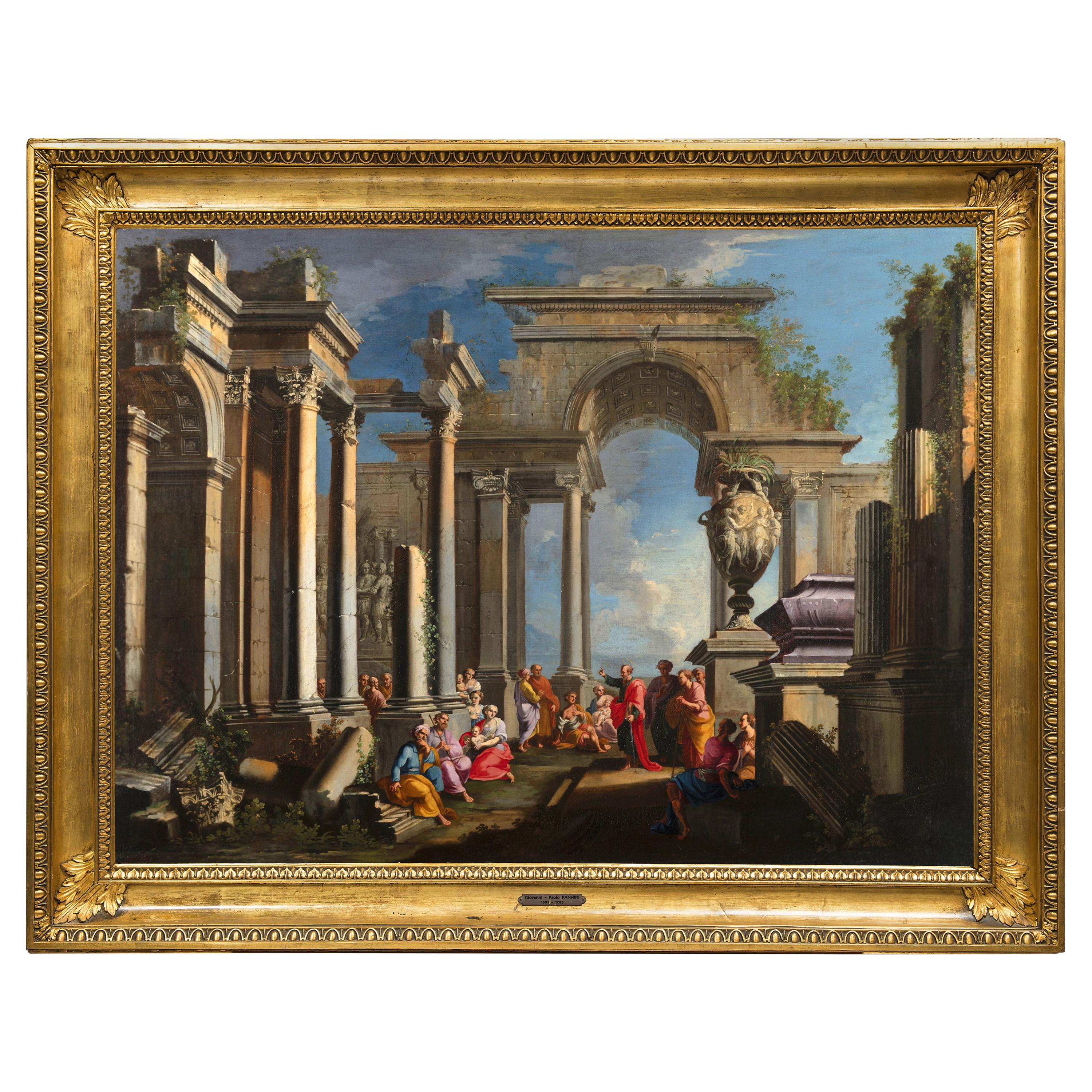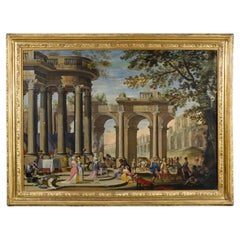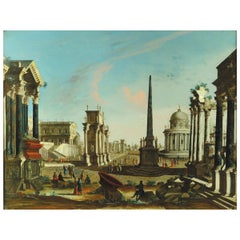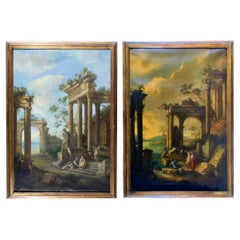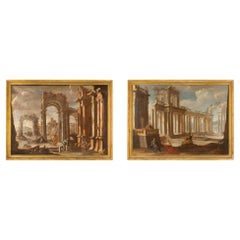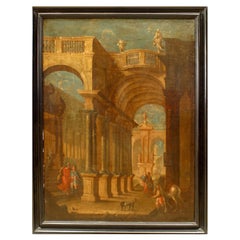Items Similar to 18th century, Couple of Italian Paintings Capriccio with Mythological Scenes
Want more images or videos?
Request additional images or videos from the seller
1 of 21
18th century, Couple of Italian Paintings Capriccio with Mythological Scenes
$77,879.33
£57,965.35
€65,000
CA$106,675.22
A$118,646.13
CHF 61,953.32
MX$1,443,797.16
NOK 791,238.45
SEK 742,042.07
DKK 494,822.31
Shipping
Retrieving quote...The 1stDibs Promise:
Authenticity Guarantee,
Money-Back Guarantee,
24-Hour Cancellation
About the Item
Couple of architectural capriccio with mythological scenes, oil on canvas, painter from Bologna active in the 18th century
The two large and valuable pantings depict two architectural capriccio, with views of colonnades and buildings with arcades of classic taste, animated by figures. The compositions are characterized by the typical complexity of Baroque painting combined with the harmony with which the painter introduces the magnificent architectural monuments and the use of perspective. The colour plays on the brown and ochre tones that stand out against the blue sky. The inclusion of figures to enliven architectural views is also balanced with the whole, bringing movement and color, with hints of red and yellow.
The architectural capriccio, an artistic genre that makes its way in Italian painting from the seventeenth century, is characterized by the representation of fantastic architectures or inventions of perspective type, sometimes combined with elements drawn freely from reality. The two paintings are an explanatory example of this type and have a considerable artistic interest.
Inside these palaces of invention are set two scenes drawn from Roman mythology or, more likely, the Aeneid. Their depiction is not easy and immediate to understand.
The artwork on the left shows, sitting on light and soft clouds, the Greek goddess Juno (Era in Greek mythology) accompanied by her animal symbol, the peacock. Juno indicates a rainbow under which, in flight, the messenger Iris is depicted. Mythical winged figure, daughter of Taumante and Elettra, messenger of the gods, in particular of Juno, Iris was identified by the ancients with the rainbow. The goddess’s appearances as a messenger in epic poems are frequent. In the Aeneid, at the end of the fourth book, when she is charged by Juno to hover over the dying Dido’s head and cut off a hair, puts an end to the agony of the queen who had a relationship with Aeneas. Again in the fifth book he carries out a mission, also for Juno: he takes the form of the old Beroe and convinces the Troyan women to burn the ships to stay in Sicily. Still at the beginning of the IX book of the Aeneid is sent, again by Juno, to warn Turn that Aeneas has left the field to meet Evander and that he is, So, the most auspicious moment to attack the Trojans.
In the painting presented here on the left, the reading of the scene is even more complex. A male figure descends from the sky on a carpet of vaporous clouds. The armor he wears, the floating red cloak and the power and austerity with which he presents suggest identification with a god. He appears to a king, as he wears a crown of gold, which bows in his presence with great respect. Around several other figures witness surprises and curious scene. It could refer again to what Virgil writes in the Aeneid. The news of the love blossomed between Aeneas and Dido, has spread.
Jupiter orders Mercury, the messenger of the gods, to descend to Carthage, to convince Aeneas to leave the queen and resume the interrupted journey. However the god here depicted with armor and lance is devoid of those iconographic references characteristic of Mercury and therefore could also be identified with the Greek god Mars (Ares in Greek mythology).
The remarkable pictorial quality emerges both from the composition as a whole and from the way in which the artist describes the views with great attention to detail, light and perfectly realistic, chiaroscuro.
Stylistically, the author of the paintings is placed among the squaring masters active in the first half of the 18th century in Bologna. The references to the majestic and scenographic architectures designed by the Galli da Bibbiena are evident, The European Union has been active in the arts for more than 150 years, first locally and then on a European scale. In particular, there is a strong closeness to the works of Ferdinando Maria Galli, known as Ferdinando Galli da Bibbiena (Bologna, 1657 - 1743). Numerous artists followed the production of Galli da Bibbiena, among them Vittorio Maria Bigari (Bologna, 1692 - 1776) came to produce works very close stylistically to the two paintings in question.
Majestic and decorative, the square-shaped canvases present the architectural whims within a round border bordered by an ochre thread that simulates a frame. This is a scenography device that was very popular during the Baroque period and which gives the whole piece greater lightness and facilitates its insertion into the frame.
The works are presented inside carved wood frames.
Art history studies are currently under way.
We apologize for any translation errors from the Italian
- Dimensions:Height: 64.57 in (164 cm)Width: 64.57 in (164 cm)Depth: 1.97 in (5 cm)
- Style:Baroque (Of the Period)
- Materials and Techniques:
- Place of Origin:
- Period:
- Date of Manufacture:Early 18th Century
- Condition:Wear consistent with age and use.
- Seller Location:IT
- Reference Number:1stDibs: LU4405240755572
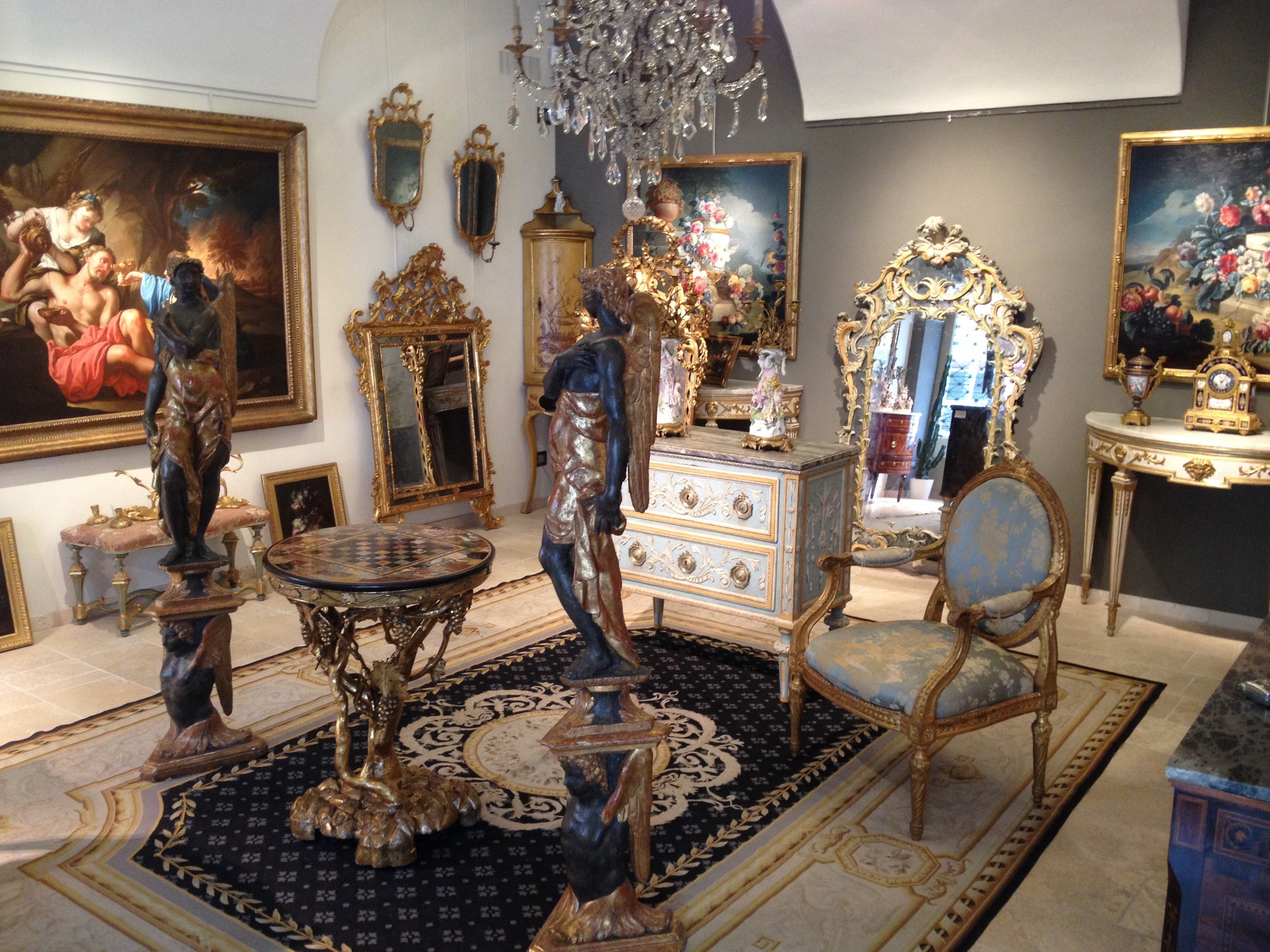
About the Seller
5.0
Platinum Seller
Premium sellers with a 4.7+ rating and 24-hour response times
Established in 1980
1stDibs seller since 2019
56 sales on 1stDibs
Typical response time: <1 hour
- ShippingRetrieving quote...Shipping from: Italy
- Return Policy
Authenticity Guarantee
In the unlikely event there’s an issue with an item’s authenticity, contact us within 1 year for a full refund. DetailsMoney-Back Guarantee
If your item is not as described, is damaged in transit, or does not arrive, contact us within 7 days for a full refund. Details24-Hour Cancellation
You have a 24-hour grace period in which to reconsider your purchase, with no questions asked.Vetted Professional Sellers
Our world-class sellers must adhere to strict standards for service and quality, maintaining the integrity of our listings.Price-Match Guarantee
If you find that a seller listed the same item for a lower price elsewhere, we’ll match it.Trusted Global Delivery
Our best-in-class carrier network provides specialized shipping options worldwide, including custom delivery.More From This Seller
View AllCouple of Italian Paintings Depicting Capricci, Francesco Aviani ‘1662-1715’
Located in IT
Francesco Aviani (Italy - Venice, 25-11-1662 / 1715) att.
Couple of paintings depicting Capricci
Oil on canvas, 135 x 183 cm, without frame
The two large and fine paintings depict two illusionistic architectural renderings, with views of colonnades and arched buildings, animated by figures. The compositions are characterized by the harmony with which the painter introduces the sumptuous architectural monuments, the mirrors of water, the buildings in the distance and the views of the landscape. Dominates with a color on the tones of brown and ochre that stands out on the blue sky, marked by some cloud of steam. The insertion of the figures to enliven the architectural views also balances with the set.
The Capriccio, an artistic genre that has made its way into Italian painting since the 17th Century, is characterized by the representation of fantastic architectures or prospective inventions, sometimes combined with elements drawn freely from reality. The two paintings are an example of this type and they are a very interesting and Fine artwork.
The remarkable pictorial quality emerges both from the composition of the ensemble and from the way in which the artist describes the views with great attention to detail, highlights and refined, perfectly realistic, chiaroscuro.
The same must be recognized for the figures: these are described with a wise brushstroke, quick and quick touches give the dynamism of the moment that is captured, as if time had stopped to show and narrate what is happening.
The painting on the right represents a large Baroque building in stone and paved with marbles, two floors, with moving façade, large columns with corinthian columns, a large portal with a staircase with large footsteps, a balustrade with string, from which some figures appear, and two equestrian monuments in bronze. The sumptuous building overlooks a large POOL of water, with a gushing fountain, around which some characters sit. In the second floor is described a white palace from which rises a tower crowned by a structure with wrought iron loggia. In addition there is a bridge and some architectural ruins behind which some mountainous reliefs fade towards the horizon.
On the staircase is described a particular scene. The people seem to be part of a very precise story. A woman, in the shadow of a parasol supported by a servant, would seem to drive out of the palace a man, who, taken under his arm by two maidens with a determined attitude, is led to a boat.
The scene could be identified with the biblical episode of the parable of the prodigal son (Luke 15,11-32), at the moment when the prodigal son is robbed and driven away by the harlots.
The episode tells of a man with two children. The youngest said to his father: “Father, give me the part of my inheritance”. And the father divided the substances. After not many days, the youngest son, collected his things, left for a far country and there he lost his substances with prostitutes and living as a debaucher. When he had spent everything, there came a great famine in that country and he began to find himself in need. Reduced to hunger, he was forced to be a pig herder to survive. He therefore meditated in his heart to go to his father and ask for his forgiveness and to be welcomed anew, even as a servant.
While still on the road, however, the father saw him and ran towards him, receiving him with open arms. He then ordered his servants to prepare a great feast for the occasion, killing for the purpose the "fatty calf". The firstborn did not understand why his brother was given such treatment, and reminded the parent that he, who had always obeyed him, had never received a single kid to celebrate with his friends. The father answered him: «Son, you are always with me and everything that is mine is yours; but it was necessary to celebrate and rejoice, because this brother of yours was dead and came back to life, was lost and was found».
The parable of the prodigal son was often portrayed in painting and the scene he finds most is certainly that of returning home in his father’s arms. Among the many is a canvas by the famous painter Giovanni Paolo Pannini (or Panini) (Italy – Piacenza, 1691– Rome, 1765) kept at the Hallsborough Gallery in London.
Rather rare, however, is the scene of the prodigal son driven and robbed by harlots. There is an engraving by Hans Collaert II (1561-1620) in which this moment is described in the background compared to the moment, narratively later, in which he is penitent among the pigs.
The second painting, certainly pendant of the first, represents a similar palace, with some characters overlooking the balustrade marcapiano and other figures around the large bathtub quadrilobata. In the foreground is described a monument with two large stone sculptures. In the distance some architectural elements and, beyond, the mountains are lost on the horizon.
The studies related to the numerous painters of architectural views and caprices, active in Italy, and the archival documents found, which could better clarify commissions, biographies and certain works, are scarce and sporadic. Therefore there are still many difficulties in reconstructing a catalogue of autograph works for each author. Through paintings in private collections, in museums and paintings passed on the antique market it is however possible to advance some attributions in order to better delineate the various artistic figures.
The style of the works studied here leads to a dating that runs between the 17th and 18th Centuries, with obvious influences dictated by the perspectives of the brothers Galli Bibiena. The analysis of the architectures and the chromatic palette suggests that we are in the presence of a northern Italian and Venetian author. Observing the decorations and the volutes, the brightness and the perspective disposition in fact, we find several analogies with those used by the Vicenza painter Francesco Aviani, excellent in pictorial perspective and architectural views.
The biographical profile of Francesco Aviani (Italy - Vicenza, 1662-1715) was essentially traced in 1956 by Andreina Ballarin, then re-visited by Federica Spadotto in 2014 and Giancarlo Sestieri in 2015. Certain documents about his life are scarce, as are the documented works.
He was born in Venice, probably on 25 November 1662, to Bernardo and a Magdalene whose surname is unknown, and was baptized on 3 December 1662. Between 1701 and 1703 he worked, together with his brother MarCo, sculptor, for the fresco decoration (now illegible) of the church villa in Soella (Vicenza). On October 16, 1703 he married Isabella Carcano. On March 26, 1715 he made a will and died on April 3 of the same year, in Vicenza.
The frescoes in the refectory of the sanctuary of Monte Berico in Vicenza are considered authentic works by Aviani, probably made in 1708; the paintings preserved in the Civic Museum of Vicenza: “Landscape with Lazzaro and the rich Epulone”; “Christ among the doctors”; “The miraculous fishing”, works not datable but with attribution corroborated by style. In addition, the frescoes in the east and west corridors of the Villa La Rotonda, near Vicenza; the fresco in the apse basin of the chapel of the church S. Croce, Vicenza, now destroyed; the frescoes of the central hall of Villa Camerini a Montruglio (1714) and a painting of a “Porto Regio”, of which we have a print engraved by Dall'Acqua.
From his works emerges the artistic background that animated the Venetian culture in the early eighteenth century. The scenic grandeur with which Aviani treats the architecture also suggests a stay in Emilia of the painter, in which he could have come into contact with the environment of the Bibiena. These contacts would be confirmed by the press of Cristoforo Dall'Acqua (Vicenza 1734-1787), “Il porto regio”, after a painting of Aviani. The press was part of a group of engravings, representing royal buildings, reproducing paintings of the Bibiena. In the eyes of Dall’Acqua, therefore, Aviani’s work was not foreign among those of the Emilians.
Inside the sumptuous architectural whims, Aviani often depicts biblical scenes, in which the characters share the space and the narrative rhythm, along with figures drawn from everyday scenes, memories of the Veronese and Bassano heritage. Also in the works covered by this study the author does not seem to want to give up a biblical subject, though the purpose of the paintings appears to be clearly a staging scenography-architectural within which the characters are relegated to the role of extras.
From the examination of the architectural Capriccio gathered under the name of Aviani then emerge common elements. The comparison between these works and the works in question highlights the proximity of the compositions. The imposing and scenic architectures are in fact equally characterized by the perspective-scenographic ability diffused in emilian “quadraturisti” and in Bibiena work. In fact, you can see the spectacular slender architecture in the lower part, the loggias that create chiaroscuro games with arches and binate columns placed on massive bases and overhung by projecting cornices.
Significant also the comparison with two paintings with architectural whims in a night vision attributed to Francesco Aviani.
In Aviani’s works it is possible to find a certain knowledge of the Roman Codazzi paint nd its early development of the eighteenth century, developed with the Locatelli, the Pannini and the less known Domenico Roberti. To Roberti have been recently attributed two works that have some compositional affinity with the canvases in question. The same can be done for a work on the antique market, attributed to Pietro Francesco...
Category
Antique Late 17th Century Italian Baroque Paintings
Materials
Canvas
18th Century, Painting Architectural Capriccio, att. to Isaac De Moucheron
Located in IT
18th Century, Painting with Architectural Capriccio with figures, attributed to Isaac De Moucheron
Measures: canvas cm H 108 x L 152; with frame cm H 132 x L 176 x 8
The painting i...
Category
Antique 18th Century Dutch Baroque Paintings
Materials
Canvas
Alberto Carlieri, Painting with Architectural Capriccio
By Alberto Carlieri
Located in IT
Alberto Carlieri (Rome 1672-1720)
"Architectural capriccio with the preaching of Saint Paul in the Areopagus of Athens"
Oil on canvas, measures with...
Category
Antique Late 17th Century European Baroque Paintings
Materials
Canvas
18th Century, Roman Architectural Capriccio Attributed to Francesco Chiarottini
Located in IT
Francesco Chiarottini (1748-1796)
Roman Architectural Capriccio
Oil on glass, cm 52 x 67 without frame, 63.5 x 79cm with frame
The valuable painting, attributed to the Italian p...
Category
Antique Mid-18th Century Italian Neoclassical Paintings
Materials
Glass
18Th Century, Pair of Italian Allegory Paintings By Vittorio Amedeo Rapous
By Vittorio Amedeo Rapous
Located in IT
18Th Century, Pair of Italian Allegorical Paintings By Vittorio Amedeo Rapous
Pair of paintings depicting the Allegory of Spring with putti and the Allegory of Autumn with putti, Vi...
Category
Antique Late 18th Century Italian Rococo Paintings
Materials
Canvas
$36,423 Sale Price
20% Off
1681, Pair of Paintings signed Grechetto da Leone as Govaert G. VAN DER LEEUW
Located in IT
1681, Pair of Paintings signed Grechetto da Leone as Govaert G. VAN DER LEEUW
Oil on Canvas
Dimensions: cm W 91 x H 123 x D 6; canvas: cm W 72 x H 103.5
This pair of fine paintings,...
Category
Antique 1680s Italian Baroque Paintings
Materials
Canvas
You May Also Like
Italian Painter of 1700 "Capriccio with classical ruins and figures"
Located in Cesena, FC
Painter of ruins xviii century:
"capriccio with classical ruins and four figures" , pendant with "capriccio with classical ruins and three figures"
Oil on canvas cm 140 x 95
The ...
Category
Antique 1730s Italian Paintings
Materials
Canvas
Pair of Italian Mid-18th Century Old Master Oil on Canvas Paintings of Ruins
Located in West Palm Beach, FL
A spectacular and extremely well executed pair of Italian mid 18th century Old Master oil on canvas paintings of ruins. Each painting displays wonderful perspectives, exceptional arc...
Category
Antique 18th Century Italian Paintings
Materials
Canvas, Giltwood
Italianate Capriccio Oil of Figures in Classical Ruins
Located in Queens, NY
Italianate style (19th Century) capriccio on an architectural oil on canvas painting with figures among classical ruins in an ebonized frame.
Category
Antique 19th Century Renaissance Paintings
Materials
Paint
18th Century Oil on Canvas Italian Antique Architectures Painting, 1760
Located in Vicoforte, Piedmont
Antique Italian painting from the 18th century. Artwork oil on canvas (glued on a board) depicting a pleasant caprice, view with architectures and characters of good pictorial qualit...
Category
Antique 1760s Italian Paintings
Materials
Canvas
Pair of Large Framed 18th Century Italian Oil on Canvas Paintings
Located in Atlanta, GA
Pair of Large Framed 18th Century Italian Oil on Canvas Paintings of Classical Scenes
Category
Antique 18th Century Italian Paintings
Materials
Canvas
A pair of 18th century Italian landscapes with classical ruins and figures
By Giovanni Paolo Panini
Located in Bath, Somerset
A pair of 18th century Italian landscapes with classical ruins and figures, circa 1750.
Circle of Giovanni Panini (1691-1765)
Thomas Agnew and Sons, Lo...
Category
18th Century Old Masters Landscape Paintings
Materials
Canvas, Oil
More Ways To Browse
Greek Red Figure
Goddess Dior
Carthage Antique
Male Peacock
Iris Goddess
Antique Bachelors Chest
Antique Bracket Clocks London
Antique Damascus
Antique English Pub
Antique Four Poster Beds
Antique French Brass Beds
Antique Islamic Pottery
Antique Oak File Cabinets
Antique Oak Filing Cabinet
Antique Sledge
Antique Travel Bar Set
Antique Umbrella Table
Antique Wagons
